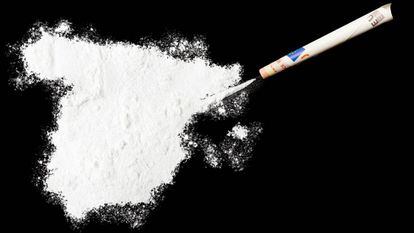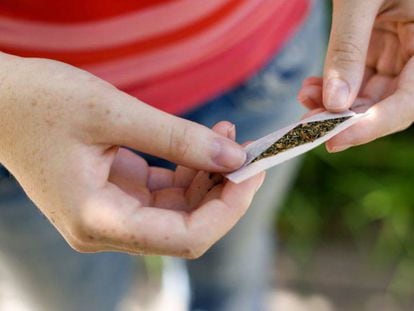A portrait of drug use in Spain
Spaniards among biggest substance abusers in Europe with cocaine and cannabis high on list

Spain has one of the highest rates of drug use in Europe and is particularly notable for its consumption of cocaine and cannabis, according to the European Monitoring Center for Drugs and Drug Addiction (EMCDDA). But it is over-the-counter drugs sold in pharmacies such as tranquilizers, hypnosedatives and sleeping pills that have the highest rates of consumption – rates that have escalated far more than in any other drug group in recent years.
While adults rely on these legal drugs, adolescents begin by experimenting with cannabis.
Here are some of the findings from the most recent report on alcohol, tobacco and illicit drugs in Spain (2015), compiled by the Government Delegation for the National Plan on Drugs (GDNPD).
The surge of psychotropic drugs
The main worry for GDNPD delegate Francisco Babín is the consumption of over-the-counter drugs that are being taken recreationally and accessed without prescription. It is this phenomenon that his department is currently focused on, though there has also been a surge in the use of over-the-counter drugs that have been prescribed to people.
“The biggest hikes are in the consumption of over-the-counter drugs with a prescription,” says Babín. “We have to assume that these drugs have been prescribed for a reason, although it could be argued that alternatives should have been explored.”
Of the over-the-counter drugs consumed with or without a prescription, hypnosedatives are the most popular, with 6.8% of people having used them in the last 30 days, followed by tranquilizers at 5.9% and sleeping pills at 3.1%. Women, particularly those over the age of 45, take twice as many of these meds as men.
The use of over-the-counter drugs is less common among the young, although there are certain circumstances in which they come into play. “They are used to moderate the rush, when they want to sleep and dull the effects of stimulants,” says Babín. Prescription meds are available on the black market but, according to Babín, many are taken from the medicine cabinet at home.
Side-effects of cannabis
Babín is on a crusade against cannabis, although he admits that an overdose is not lethal, and that its use is less harmful to health than other drugs. However, he advises that it can be lethal in other ways.
“More than any other substance, cannabis is a killer on the road, even if users won’t die from an overdose,” he says.
Experts believe Spain could be facing a new cocaine epidemic
The most recent report from Spain’s National Institute of Toxicology and Forensic Science (INTCF), published in July 2016, shows that of the 275 dead drivers in the study who tested positive for substance use, 67% had consumed alcohol, 30% had taken an illicit drug and over 26% had consumed over-the-counter meds. But among the 30% who had used an illicit drug, cannabis was not the most common drug found; cocaine was present in 49% of cases and cannabis came second (44%).
According to the GDNPD, 70% of all cannabis hauls in Europe take place in Spain. The delegation also points out that in recent years marijuana use – as opposed to cannabis use – has risen. Cannabis in the form of resin comes mainly from Morocco but there are an increasing number of marijuana farms in Spain, particularly in the regions of Almeria and Murcia. “It is often grown here but distributed to coffee shops [in Holland where it is legal to consume cannabis],” says Babín, who complains that unilateral policies on the issue mean that one country can end up paying the price for another’s approach.
Spain ranks among the top cocaine users in Europe
Spain has long been the gateway to Europe for cocaine producers in Latin America and elsewhere, which exacerbates consumption within the country. “For a long time, we topped the tables for cocaine use and although we are now in second place, we can't be complacent,” says Babín. For instance, the EMCDDA’s Statistical Bulletin shows Spain still has the highest score for the ‘prevalence [of use] in the last month’ category. “It's pretty worrying, although consumption has dropped in the last decade,” says Babín.
Between 2005 and 2013, daily cocaine use in Spain dropped by 37% and demand also fell for support for recovering addicts. “Cocaine was in the spotlight for a long time because there was an epidemic,” says Babín, adding that this focus on the drug also accounts for the drop in its use. Now, although only 1% of people in Spain are habitual users of the drug, its prevalence and the consequences of use of the drug have led the GDNPD to suggest we are on the brink of a second epidemic.
Playing Russian roulette with new substances
Nexus, mephedrone and spice are just some of the new psychoactive substances available nowadays. “It is safe to say that 57% of the population have never heard of them,” says Babín. “But they are all over the Internet and that’s where the dealing takes place.” Most are produced in the north of Europe, but 99% of the raw material comes from China.
Interestingly, more boys than girls are prepared to experiment with these substances. “It's like Russian roulette,” says Babín. “They don't know what the effect will be. It could be something terrible.” It is easy to produce these substances in the lab with very little raw material, some of which has sidestepped official checks. Fortunately, the use of these substances is still not widespread.
Meanwhile, the alarming hike in the use of heroin in the US has put Spanish drug authorities on alert. But according to Babín, there is no reason to believe that Spain is embracing heroin again. “There is still a large chunk of the population that lived through the 1980s heroin epidemic and there is a lot of caution,” says Babín. “There are people who use it, but the percentage is insignificant and we are light years away from an epidemic.” He does add, however, that the authorities should keep their eye on generations coming through who did not witness the havoc heroin wreaked on Spanish society in the 1980s.
Teenage flirtation with cannabis
One of Babín’s main concerns is cannabis use among teenagers. “One out of four kids between the ages of 14 and 18 has tried it,” he says. “If we don't do something decisive, there will be alarming consequences.”
He points out that the use of cannabis outstrips that of all other drugs except for alcohol. “It is relatively common for a teenager using cannabis to end up in hospital suffering a psychotic episode,” he says.
Legalize it?
The GDNPD (set up by the ruling Popular Party in Spain) is radically opposed to the legalization of cannabis. However, new political parties Podemos and Ciudadanos as well as the United Left are in favor of changing the law while the PSOE socialist party proposes debate on the issue.
In the Spanish speaking world, countries such as Mexico have taken the first steps towards legalization for medicinal purposes and Colombia has issued its first license for medicinal marijuana while, in the US, more than 20 states allow it for medicinal purposes and eight have gone as far as legalizing it for recreational use.
Experimenting with new drugs is like playing Russian roulette Francisco Babín, drugs expert
Former US President, Barack Obama, said in November 2016 that although legalization is not a panacea, he believes cannabis should be treated as a public-health issue. “I’ve been very clear about my belief that we should try to discourage substance abuse,” Obama told the magazine Rolling Stone. “But treating this as a public-health issue, the same way we do with cigarettes or alcohol, is the much smarter way to deal with it.”
In Europe, there is a fragmented picture that ranges from the long Dutch tradition of legal consumption to the French approach, which make no distinction between hard and soft drugs.
English version by Heather Galloway.













































